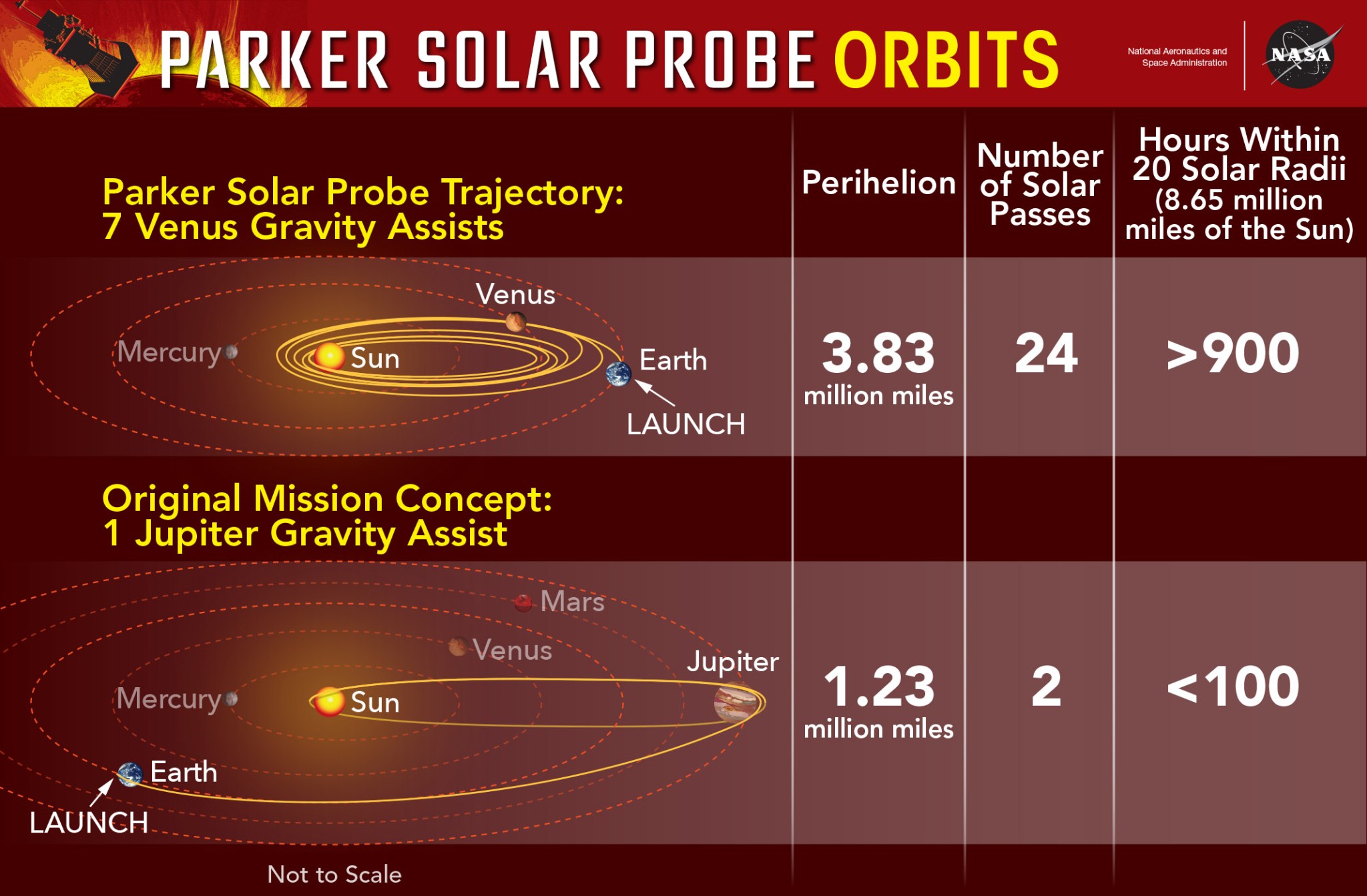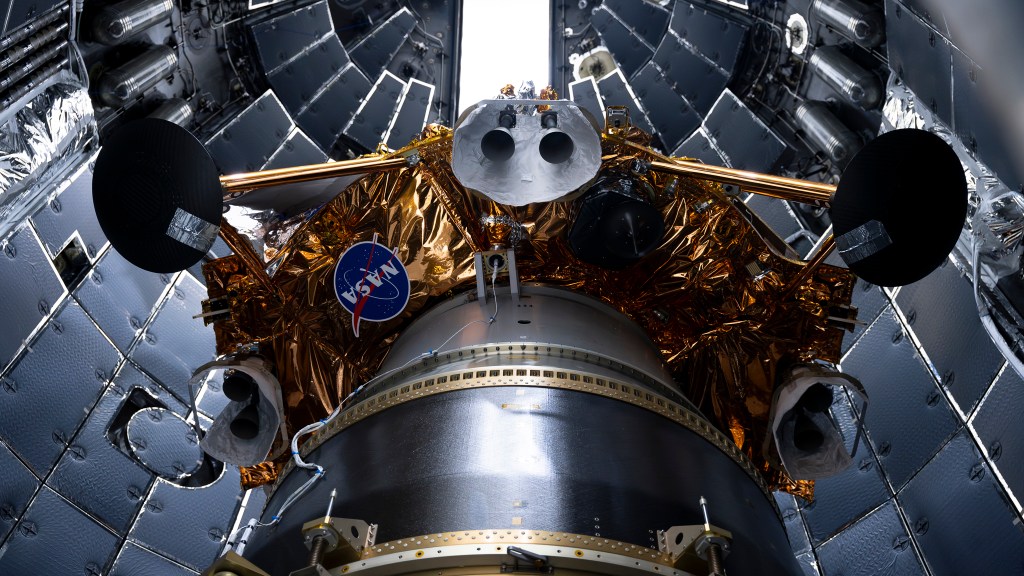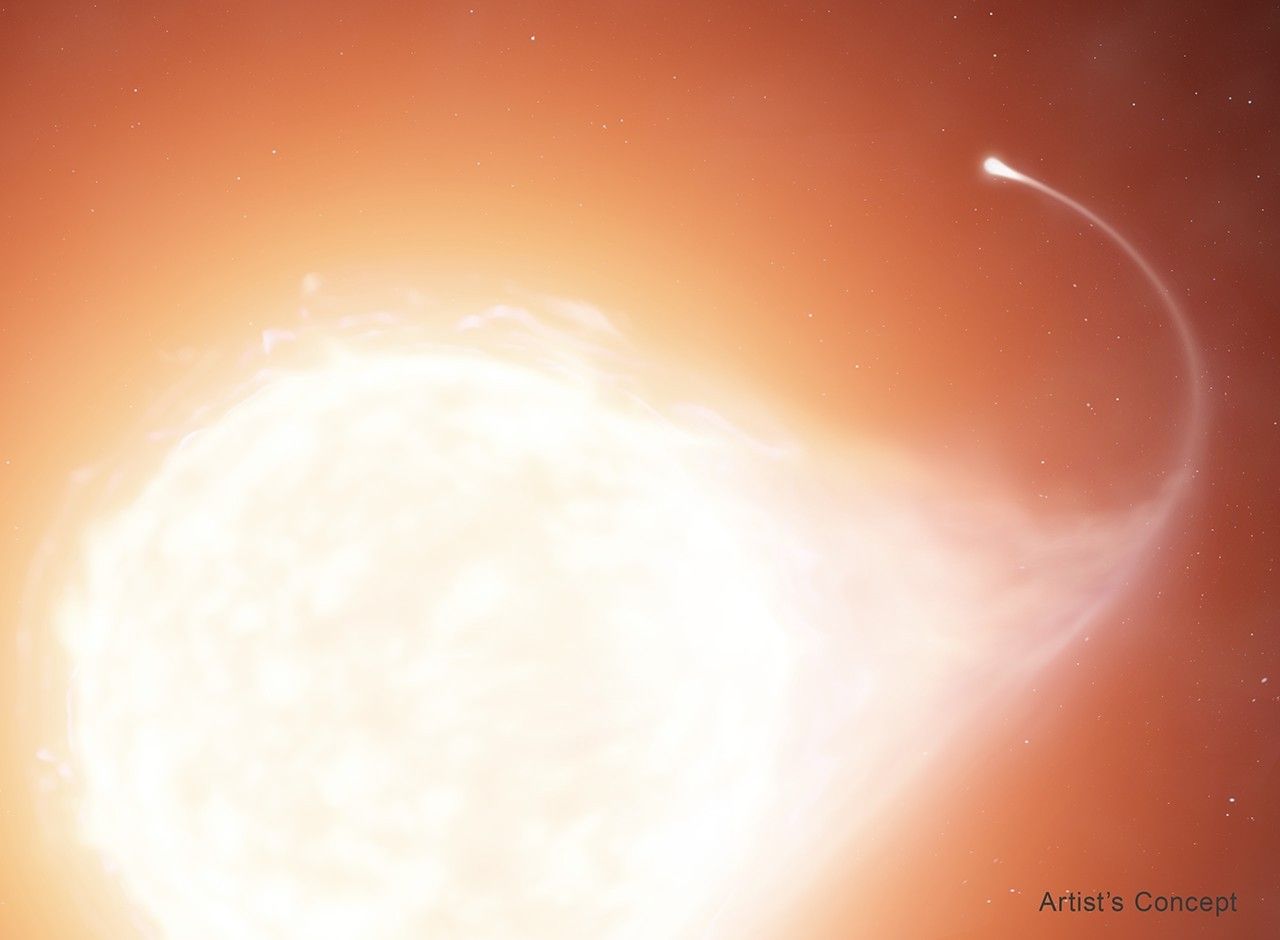On Oct. 3, 2018, Parker Solar Probe performed the first significant celestial maneuver of its seven-year mission. As the orbits of the spacecraft and Venus converged toward the same point, Parker Solar Probe slipped in front of the planet, allowing Venus’ gravity — relatively small by celestial standards — to twist its path and change its speed. This maneuver, called a gravity assist, reduced Parker’s speed relative to the Sun by 10 percent — amounting to 7,000 miles per hour — drawing the closest point of its orbit, called perihelion, nearer to the star by 4 million miles.
Performed six more times over the course of the seven-year mission, these gravity assists will eventually bring Parker Solar Probe’s closest approach to a record 3.83 million miles from the Sun’s surface — about a seventh the distance of the current record-holder, Helios 2, which achieved a pass of 27 million miles from the Sun in 1976. Even before its closest approach, Parker Solar Probe is expected to overtake this record and become the closest human-made object to the Sun in late October 2018.
A long-held dream
A solar probe has been on the minds of scientists and engineers for decades, since the late ’50s, when a new theory and the first satellite measurements of the Sun’s constant outflow of material, called the solar wind, pointed towards previously unsuspected complexity. But if you’d asked anyone before 2007 — well after serious planning for such a mission began — Venus would not have come up as the key to the mission puzzle. For the three-plus decades that various committees and teams worked on different concepts for the solar probe mission, it was widely agreed that the only way to dive into the solar atmosphere required sending the spacecraft to Jupiter first.
“No one believed using Venus gravity assists would be possible, because the gravity assist a planetary body can provide is proportional to the body’s mass, and Venus’ mass is so much smaller — only 0.3 percent of Jupiter’s,” said Yanping Guo, mission design and navigation manager for the Parker Solar Probe mission at the Johns Hopkins University Applied Physics Lab in Laurel, Maryland. ” You compare the gravity assist Venus can provide to what Jupiter can provide, and you have to do repeated flybys to achieve the same change. Then you’re getting a very long mission duration.”
Getting close to the Sun is more difficult than one might think. Any spacecraft launched from Earth starts off traveling at our planet’s 67,000-mile-per-hour sideways pace, speed that it must counteract before it can get anywhere near the Sun. Gravity assists are one of the most powerful tools in an orbit designer’s toolbox to solve this problem: Instead of using expensive, precious fuel to change direction or speed (or both), gravity assists let you harness the natural pull of a planet, with time as the only cost.
Credits: NASA’s Goddard Space Flight Center
Most deep-space missions that use planetary gravity assists use them to gain speed — like OSIRIS-Rex, which used Earth’s gravity to rocket towards asteroid Bennu — or to change direction — like Voyager 2, which performed a gravity assist after its final planetary flyby at Neptune to bank toward its moon, Triton.
The idea for a solar probe gravity assist was a little different. In the original orbit plans, the primary functions of the Jupiter gravity assist were to slow the spacecraft’s speed to almost nothing and fling it upwards, out of the nearly-flat plane that contains all of the known planets of the solar system, called the ecliptic plane. This would put the solar probe on a path to get a rare and better-than-ever look at the Sun’s polar regions, which are difficult to image, but important scientifically as they produce some of the Sun’s high-speed solar wind. Nearly all of our solar observatories have orbited in the ecliptic plane, with the exception of Ulysses, which used a Jupiter gravity assist to achieve polar passes more than 200 million miles from the Sun.
But sending a spacecraft out to Jupiter and bringing it back into the inner solar system is hard. First, no matter how you plan the journey, it’s a long mission, with a minimum of nearly half a decade between meaningful events. Most of the time would be spent cruising in deep space.
Second, traveling that far from the Sun means you have to get creative with power. Near Jupiter, the sunlight is about 25 times dimmer than what we experience at Earth, so the only options are huge solar panels to make the most of the sparse sunlight, or some other source of power, like nuclear. Large solar panels pose a problem for a solar probe, though, because the panels would need to be shielded during solar encounters to avoid overheating. The size of a solar panel required to power the spacecraft out near Jupiter is too big to effectively stow near the Sun, so they’d have to be jettisoned at perihelion — and that limits you to just one solar pass, once you’ve lost your source of power. With nuclear power — a radioisotope thermoelectric generator, or RTG, the same source that powers deep-space missions like Cassini and New Horizons — performing a Jupiter gravity assist is a viable option.
Changing the mission paradigm
But the mission design was soon to change. David McComas, chair of the definition committee, remembers a call from Andy Dantzler, then project manager for the Solar Probe mission at APL. Dantzler passed away in 2011 at age 49; the Delta IV Heavy rocket that carried Parker Solar Probe to space was dedicated to him.
“Andy asked if there was any way the committee might go for a mission where you stay in the ecliptic plane but have lots of passes by the Sun and slowly reduce the perihelion,” said McComas, who is now the principal investigator of the mission’s Integrated Science Investigation of the Sun, or ISʘIS, suite and a professor of astrophysical sciences at Princeton University in New Jersey.
This was an entirely new paradigm for the mission. A hallmark of the original plan was passing over the Sun’s poles, the source of the Sun’s fast solar wind but a region of relative mystery to scientists. Additionally, staying in the ecliptic plane would almost certainly mean ending up farther from the Sun than had previously been anticipated.
“If you’re trading perihelion distance, you have to swap it for something that will give you opportunities to fill in the science in some other way,” said McComas.
Subsequently, two developments supported the choice to make these changes to the orbit and create the Parker Solar Probe mission we know today.
The first was new research published in 2009 by Thomas Zurbuchen — then a scientist at the University of Michigan and now the associate administrator for the Science Mission Directorate at NASA Headquarters in Washington. This research showed that the solar wind that could be measured from the ecliptic plane was actually from a diverse mix of sources. It was not only the slower solar wind known to be more common near the Sun’s equator, but also the high-speed solar wind that often originates closer to the Sun’s poles. By sampling the solar wind from the ecliptic plane over a period of years, scientists could learn about this fast solar wind in ways they hadn’t previously anticipated.
The second development was the shift that made such sampling possible: the design of Parker Solar Probe’s current trajectory.
“When starting, I had no clue if I could find a solution,” said Guo, the mission trajectory designer. “Everybody thought Jupiter was the only practical way you could get closer to the Sun, within 10 solar radii.”
In 2007, she came up with five alternative options that would keep the spacecraft near the ecliptic plane and would not require traveling out to Jupiter. These trajectory options used some combination of Earth and Venus gravity assists to gradually draw the spacecraft closer to the Sun over the course of a number of years. One fulfilled all the requirements for the Solar Probe mission — a total mission duration under 10 years, with a final close approach clocking in under 10 solar radii (equivalent to 4.3 million miles). This was chosen as the trajectory of the current mission, now called Parker Solar Probe after Dr. Eugene Parker, including seven Venus gravity assists that spiral the orbit in closer and closer to the Sun over the mission’s seven-year lifetime.

Download the Parker Solar Probe orbits infographic
The biggest hurdle to overcome for a trajectory with such repeated gravity assists is phasing. Of course, Venus is in constant motion around the Sun, so every time the spacecraft passes the planet and swings around our star, Venus is in a completely different place. But Guo’s design solves that problem, with multiple opportunities for launch. This trajectory design carries the spacecraft through 24 orbits around the Sun. The seven Venus gravity assists happen at different points in the spacecraft’s orbit, to account for the phasing problem — some, like the one on Oct. 3, happen as the spacecraft heads towards the Sun, while the others happen as Parker Solar Probe speeds away from the Sun.
This orbit is decidedly different than the original single-Jupiter-gravity-assist concept. Rather than two passes over the Sun’s poles, coming within 1.23 million miles of the surface, this version of the mission provides 24 passes around the Sun near its equator, coming within 3.83 million miles of the Sun’s surface.
Though Parker Solar Probe doesn’t get as close to the Sun, this version of the trajectory provides the spacecraft with more than 900 hours in this critical inner region of the Sun’s corona, within 20 solar radii (about 8.65 million miles). In comparison, earlier designs using Jupiter gravity assists provided less than 100 hours in this region.
“Here was this technical solution that was safer and cheaper and a better scientific mission because of all the samples we’d be getting,” said McComas. “The Sun isn’t a stable object — it’s variable — so this would let us do a better scientific job.”
This change to the mission also solved the power problem. Instead of requiring an RTG or unmanageably-large solar panels, Parker Solar Probe is powered by a pair of articulated solar panels that are slowly drawn into the shadow of the heat shield as the spacecraft approaches the Sun. At closest approach, only a small area remains exposed to generate the needed power for the spacecraft, cooled by the mission’s first-of-its-kind solar array cooling system.
But though it solved a major problem, rethinking the mission in this way also required a complete rethinking of the spacecraft itself.
“The whole spacecraft design changed dramatically,” said Nicola Fox, formerly the mission’s project scientist at APL. Fox is now the director of the heliophysics division at NASA Headquarters. “With the earlier trajectory, the heat shield was the spacecraft. It was like a cone, with the pointed end facing the Sun, because when you’re doing such a fast polar orbit it’s tough to keep a shield oriented correctly.”
“We aren’t going in as far with the new trajectory, so we could go to a simpler shape for the heat shield, because it’s possible to keep the heat shield oriented between the spacecraft and the Sun at all times. The whole thing looks really different.”
The mission team credits Andy Dantzler with guiding them through this fundamental change in the mission’s design that led to the mission we know today.
“When Andy called and asked if the definition team would go for it, I really didn’t know the answer,” said McComas. “As our definition team worked through the science, I became convinced that it wasn’t just an equivalent mission, but actually a better scientific mission, because we get so much more time close to the Sun and so many more samples at different times.”
The first flyby
During the Oct. 3 gravity assist, Parker Solar Probe came within about 1,500 miles of Venus’ surface, reaching this closest point at about 4:45 a.m. EDT.
Venus is an interesting case for heliophysicists, who study not only the Sun, but also its effects on planets. Unlike Earth, Venus doesn’t have an internal magnetic field — instead, a weak magnetic field is induced over the surface by the constant barrage of solar charged particles flowing over the planet and interacting with its very dense atmosphere.
This first flyby offered a unique opportunity for calibration, as Parker Solar Probe flew through the trailing end of Venus’ magnetic field, called the magnetotail. Three of Parker Solar Probe’s four instrument suites — SWEAP, ISʘIS and FIELDS — gathered data during the flyby on particles and fields in this region.
Though the data is still making its way back to Earth, the science team hopes to analyze it before they set their sights on Parker Solar Probe’s next major celestial encounter: its first close approach to the Sun. Parker Solar Probe’s first solar encounter will happen Oct. 31 – Nov. 11, with the closest approach happening on Nov. 5 at a distance of 15 million miles from the Sun. The science data from this encounter will start downlinking to Earth in early December.
Parker Solar Probe is part of NASA’s Living with a Star program to explore aspects of the Sun-Earth system that directly affect life and society. The Living with a Star program is managed by the agency’s Goddard Space Flight Center in Greenbelt, Maryland, for NASA’s Science Mission Directorate in Washington. APL designed, built and operates the spacecraft.
Related:
By Sarah Frazier
NASA’s Goddard Space Flight Center, Greenbelt, Md.


























